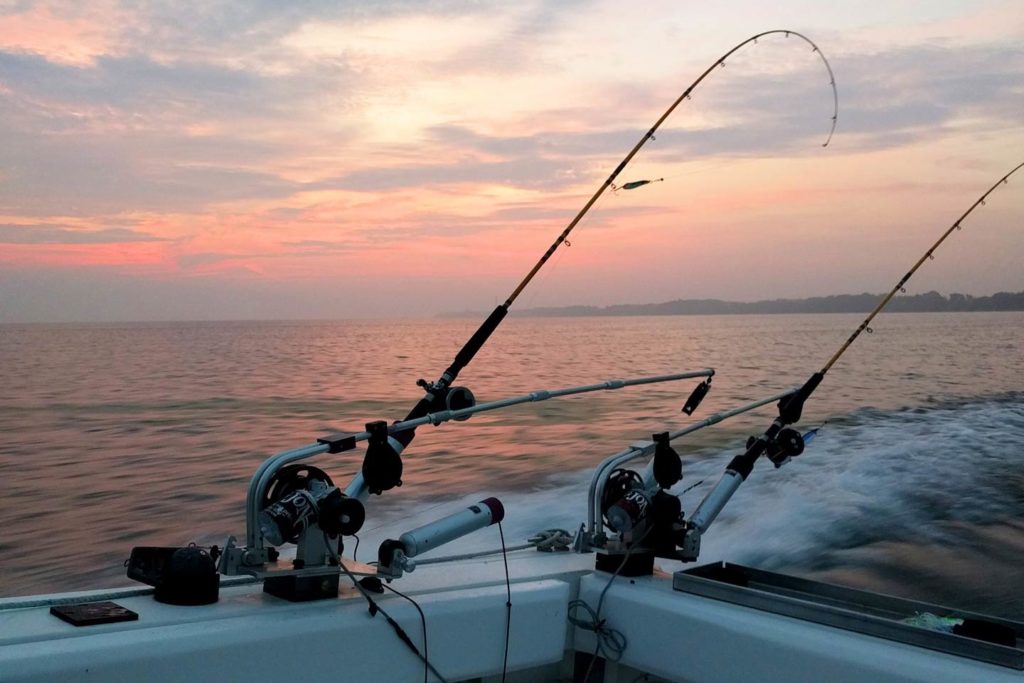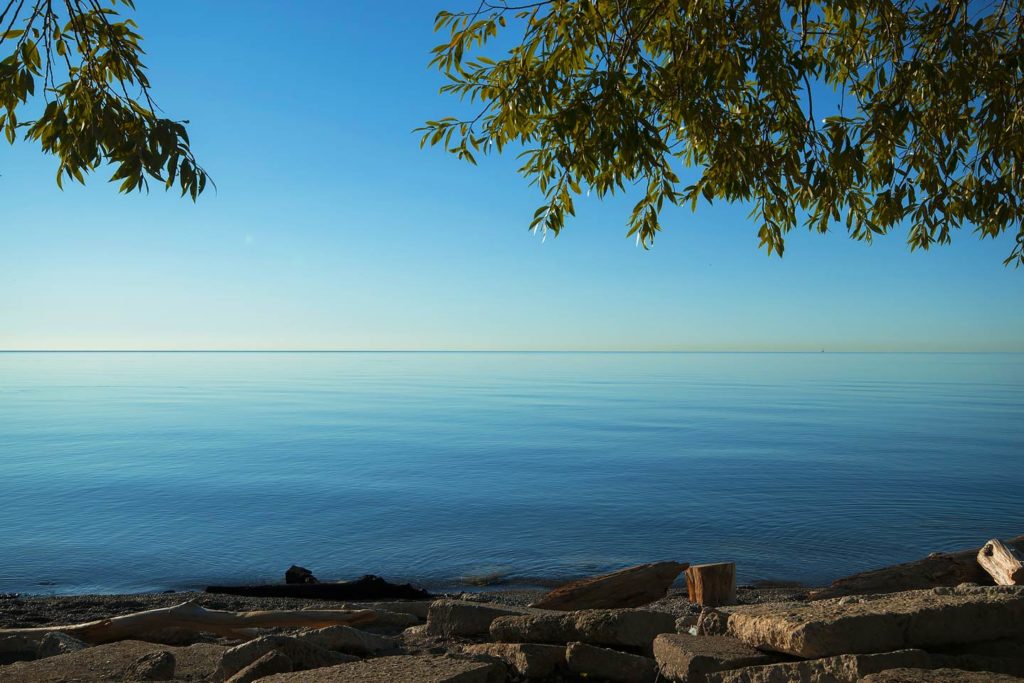It doesn’t get much better than a Lake Ontario Salmon fishing trip. And while it may be the smallest of the Great Lakes, you’d never be able to tell judging by its fantastic fishery. It wasn’t always like this, though. Salmon were first stocked in Lake Ontario in 1968, just over 50 years ago. Luckily, they took to their new environment quickly!
Over the years, the decision to stock the lake with Chinook and Coho varieties has had a positive economic impact on small shoreline communities and drawn many anglers to upstate New York and Southern Ontario fisheries. It’s been so successful, that today, these fish are considered the lake’s shining stars.
Salmon are stocked in the waters yearly, and there’s even some natural reproduction happening. Their size, flavor, and fight are just a few of the reasons by anglers flock to Lake Ontario to hook ‘em. In this guide, we’ll tell you everything you need to know about when, how, and where to hook your next trophy.
What fish can I hook and when?
There are two types of Salmon you can count on hooking in Lake Ontario – Chinook and Coho. You’ll find these fish inhabiting similar waters at similar times. Still, there are some differences between them. Read on to find out more about your top two targets.
Chinook Salmon

There’s a reason anglers call them King Salmon – these fish are some of the lake’s most treasured possessions! Their hard-fighting nature, absolutely delicious flavor, and limited availability all contribute to why Chinook Salmon are so popular. With Lake Ontario specimens hitting up to the 30-pound mark, it’s no surprise that anglers choose to cast a line here.
The start of the Chinook fishing season varies from year to year. This depends in large part on how cold the winter was and where the waters warm up first. Typically, things get going in the lake’s western basin in April. Chinook prefer colder temperatures, ideally at around 53 Fahrenheit, so the warmer it gets the further offshore you’ll have to go. You’re looking at fishing anywhere between 100–500 feet deep.
That all changes come late summer, however. As the fish prepare for their fall spawning run, they begin to move into the mouths of the lake’s tributaries. This is when the action really gets going and the waters are at their busiest. The Salmon are big, aggressive, and only around for a short window of time. September through early November is typically peak season, though some fish may linger for longer.
Coho Salmon

The King’s silvery cousins boast similar attributes in terms of their aggressiveness and great taste, but Coho Salmon don’t get quite so large. A 20-pounder is considered a trophy, and most fish come in at between 5–10 pounds. Nevertheless, the largest Coho ever caught was pulled out of Lake Ontario’s waters. The fish in question weighed over 33 pounds, which just goes to show that this fishery breeds some incredible specimens.
There are some key differences and similarities between Coho and Chinook salmon. Both prefer similar water temperatures, so you’ll often find them in the same areas at the same time. The lifespan of a Coho is shorter, however, and so is your window for fishing. They also spawn a little later. Peak season typically occurs between October and early November.
Lake Ontario Salmon Fishing Techniques
Salmon can be a tricky species to hook. To make things a little easier for you, we’ve highlighted some of the most popular ways to do so in Lake Ontario.
Trolling

Trolling is by far the most popular fishing technique for hooking Salmon on Lake Ontario. Why? Well, because the lake is massive. When trolling, you’ll have multiple lines in the water and the ability to cover more ground in search of productive spots. To narrow it down even further, check the temperature of the water. Salmon like to coast at between 52–58 Fahrenheit.
The next thing you’ll want to think about are lures. Most anglers agree that the best lures for Lake Ontario Salmon fishing are spoons. They’re bright and shiny in color and move aggressively in the water, all of which attracts fish. If you’re fishing deeper waters it’s also a good idea to have dipsy divers and downriggers on hand. These will allow you to reach greater depths.
Lastly, remember that Salmon are most likely to hit your lure out of pure aggression – and when they hit, they hit hard. Gear up with lead wire and don’t underestimate their power.
Drift Fishing

This is a great technique to employ once the fish have moved into the river mouths. You’ll be able to cover a lot of water and present your bait or lure in a natural way. The key to drift fishing successfully is finding the right weight for your rig. You want your bait to line up with your target’s mouth. Determining at what depth that is will depend on the current.
If you’re exploring a few different areas, you may need to switch rigs more than once during a single trip. As such, drift fishing is recommended for anglers with experience. Gear up with a medium-heavy spinning or drifting rod and use egg sacs or skein for bait.
Fly Fishing

This one’s reserved for the really skilled anglers among you. Fly fishing is hard to master in general, but Salmon are especially tough targets. The best time to show off your skills is once the fish move into the tributaries. As ever, water temperature is an important factor. Do a quick measure before you start casting to eliminate any potentially unproductive spots.
When it comes to choosing your gear, go for a 9–10 foot rod, paired with line weights between 7 and 9. Salmon are powerful fighters so they warrant heavier gear. As for your flies, egg imitations, streamers, or nymphs work well.
If you’re planning to get in the water and wade, please be aware of your surroundings. The waters in the tributaries are full of slippery rocks, deep drops, and ever-changing currents and water levels.
Lake Ontario Salmon Fishing Spots

During spawning season, you’ll find Salmon in nearly all of Lake Ontario’s tributaries – that’s how incredible this fishery is! Below we’ve highlighted some of our favorite fishing spots on both sides of the border.
Salmon River
When it comes to Lake Ontario Salmon fishing, this is every angler’s mecca. Easily accessible from Pulaski and Oswego, the Salmon River is the lake’s most heavily stocked tributary. Its fall Chinook run is fantastic for several reasons. The river is large, has consistent flow, is easily accessible, and boasts fly fishing only zones. An additional bonus? 70% of the Chinook caught here are wild.
Douglaston Salmon Run
This two-mile private stretch of the Salmon River is arguably the best spot to set up. It’ll cost you an additional fee to fish here, but local anglers will tell you it’s well worth it. Its location on the lower end of the river is one of the main reasons it’s so good. The fish first enter the river here, meaning they’re fresh and raring to bite.
Port Credit
If you’re fishing on the Canadian side of the border, don’t skip a visit to Port Credit. This shoreline community in Mississauga is often referred to as “the birthplace of Salmon.” The fish start to make moves in early July, inhabiting waters between 50–200 feet deep. Once the nearshore waters warm, head up to 12 miles offshore to fish depths over 300 feet.
Ganaraska River
Another fantastic choice on the Canadian side of Lake Ontario is the Ganaraska River. It runs right through the middle of Port Hope and it’s considered one of the top destinations for Salmon and Trout. Around mid-August, both Chinook and Coho Salmon make their annual migration upstream. Visit the Ganny River at this time and you’ll be in the prime spot to reel in some fish.
Anything else I need to know?

Salmon are a highly regulated species. To ensure you’re fishing within the law, it’s important to keep a few things in mind. We’ll start off with fishing licenses and bag limits, and finish off with whether these fish are safe for consumption.
Fishing Licenses and Bag Limits
The most important thing to bring with you is a valid fishing license. If you’re fishing on the American side of the border that means picking up a New York state license for all anglers over the age of 16. For a more detailed look at the different types of licenses, check out this guide. Anglers between the ages of 18–65 will need an Ontario fishing license to fish in Canada.
Bag limits will vary depending on where you’re fishing. Typically, the limit in New York state is a total of three Chinook or Coho Salmon daily. In Ontario, it’s five. There are also sections of the lake and its tributaries that are catch and release only. These rules are subject to change on an annual basis and it’s always best to double-check before heading out.
Good to eat?
Lake Ontario has suffered its fair share of pollution, but great efforts have been put in over the years to remedy some of those effects. As such, Lake Ontario Salmon have been deemed safe to eat – albeit sparingly. Local authorities recommend no more than four meals per month. You can assure healthier eating by trimming fat, removing the skin, and cooking your catch.
Lake Ontario Salmon Fishing: Simply Put, Legendary

It’s no surprise that Chinook and Coho Salmon are Lake Ontario’s stars of the show. With stocked tributaries, record-breaking fish, and multiple ways and places to cast a line, who wouldn’t want to fish here? We know we do – and so do you!
Are you planning to fish Lake Ontario for Salmon this coming season? Drop us a line in the comments and let’s connect – we love to hear from you!